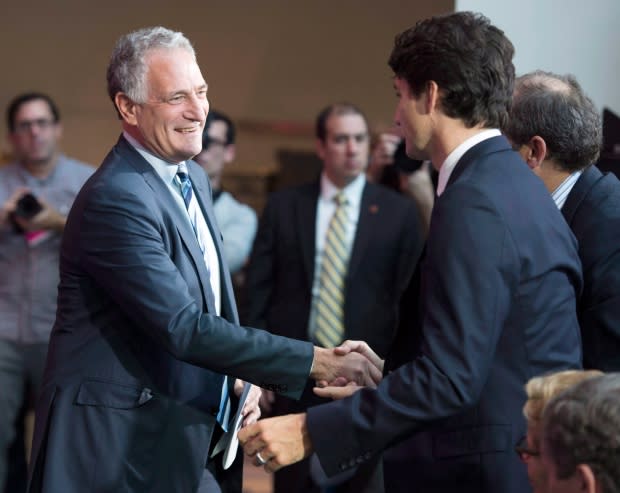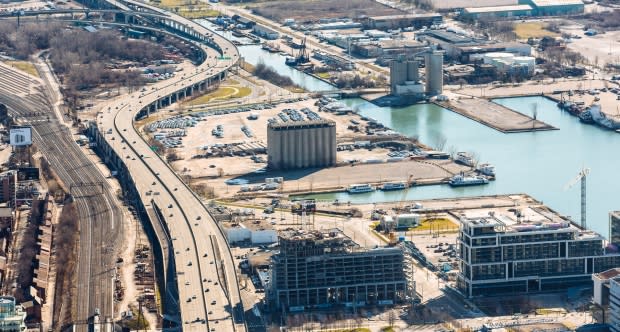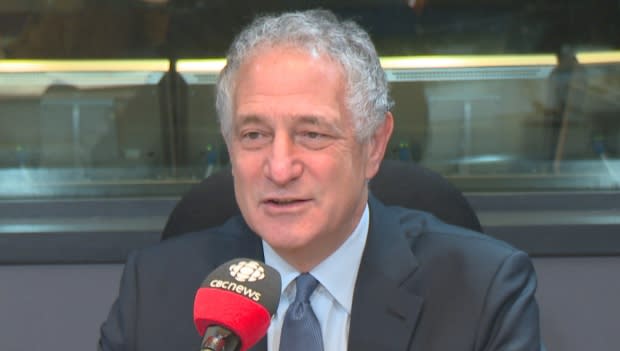Sidewalk Labs defends compensation plan for waterfront project
The CEO of Sidewalk Labs is defending a proposal by the company that would see it compensated in return for work on creating a high-tech community on Toronto's waterfront.
Dan Doctoroff says Sidewalk Labs is proposing to capture some "incremental revenues" that would be generated from its proposed investment in infrastructure. According to media reports, those revenues include a share of property taxes and development fees that usually go to the city. It would also reportedly like a share of an increase in land values.
"If we actually play a role in financing something that otherwise isn't going to get done, we obviously have to get paid back," Doctoroff told CBC Radio's Metro Morning on Wednesday.
Sidewalk Labs, which is planning to develop a parcel of the Port Lands known as Quayside in partnership with Waterfront Toronto, has said it wants to expand its proposal for the community by funding transit and underground infrastructure.
In return for funding a light rail transit line along the waterfront, the organization hopes to receive some of the profits generated from development charges and increased land value.

The company, backed by Alphabet Inc., Google's parent company, has said the arrangement will allow transit to be built "years, if not decades, sooner than it would otherwise," though Sidewalk plans to pass off the operation of the transit line to a public agency.
'Profiting through development'
Doctoroff described the business model under the plan as "profiting through development."
"We are simply saying, because our parent has very patient capital, we can actually put out the money to extend the LRT, and wait to get paid back until there is actually development in the area that would not have been created but for the investment in infrastructure," he said.
He acknowledged that the proposal has generated criticism, controversy and questions but Doctoroff called it "just a concept" and said it came from a leaked preliminary document.

Critics of the project, including Toronto Coun. Gord Perks, have said it is time to look at whether the entire enterprise should be scrapped.
The project — a partnership with Waterfront Toronto that hopes to bring affordable housing, heated sidewalks, raincoats for buildings and autonomous vehicle infrastructure to 12 acres of the city's waterfront — has been mired in controversy since Sidewalk won a contract in 2017.
For his part, Doctoroff said the business model would be applied only to two sites, Quayside and the site where Google's proposed headquarters in Toronto would be developed.
He acknowledged, however, that the company is thinking about the project being bigger than 12 acres.
"We do recognize that, as a American company coming in here, there's going be a lot of skepticism, that there is going to be a lot of questions that are going to be asked," he said.

Metro Morning host Matt Galloway spoke with Dan Doctoroff about the company's plans for expansion and compensation and the criticism that it has generated.
You can listen to the whole interview or read a transcript below.
Questions and answers below have been edited and condensed for clarity.
Matt Galloway: When this project started, there were critics who were wondering whether your ambitions were greater than what you were revealing. Have those critics been proven right?
Dan Doctoroff: Absolutely not, in the sense that, somehow there's this perception that there has been a bait-and-switch. If you go back to the original Waterfront Toronto RFP (request for proposal), it mentioned the eastern waterfront 20 times. Our response mentioned it many times. The city council report mentioned the need for scale in order to achieve the aspirations that Waterfront Toronto and its constituent governments actually wanted to achieve. And so, this is really quite consistent with everything that was said right from the very beginning.
MG: You and I have talked about this. At the very beginning, the talk was about 12 acres.
DD: The conversation actually has always been about what scale do you need, what do you need to do in order to transform this area that, for a hundred years, has been lying fallow. And there's a reason for that. The reason is, it's really hard. But if you go back to the original RFP, if you go to our response, if you go to the city council report, if you go to our planned development agreement, in all cases, they said, look, if you got to look broader in order to achieve the objectives, and let's remember what the objectives are. We are trying to do something that's really different here. We are trying to address the issues of affordability. We are trying to come up with new approaches to mobility. We are trying to really create a conclusive economic opportunity. You at least have to think more broadly.
MG: You have said this parcel of land has been "stubbornly resistant to development." What do you mean by that?
DD: Again, the land that is now the Port Lands, was first filled in in 1912. It's been a hundred and seven years. It was originally conceived as the answer for Toronto's industrial waterfront expansion. It never happened. First, the depression intervened, and then World War II, and after World War II, Toronto's manufacturing base, like the manufacturing base of virtually all northeastern North American cities, started to decline. There have been attempts to actually develop that over the years. None of them have come to pass. And the reason is, it's because it's really, really difficult. There's no infrastructure over there. There's no mass transit to the area.
MG: Is that work not underway? Levels of governments have committed more than $2 billion to the revitalization of the mouth of the Don River, which will prevent flooding. Is that not suggesting that the development is on its way?
DD: That is a precursor, but there is still no mass transit there and no plans for mass transit. People have been talking about the extension of the Queens Quay LRT East for over 10 years. I think everyone would recognize that it's not a high priority, given all of the other transit priorities, particularly in the communities for which there is a political constituency.
MG: Do you believe that the LRT won't be built if Sidewalk doesn't fund it?
DD: I believe it will take a long time. In fact, interestingly, the Waterfront Business Improvement Association just issued a report about two weeks ago that said that, if as expected, the LRT isn't extended until 2045, then the city will lose $20 billion of economic output.
MG: But there is a plan. It is a priority for the City of Toronto.
DD: It's actually on the list, but it's low on the list. And part of the reason it is low on the list is because there's nobody who lives out there. And we all know from the nature of politics that, until there are people are demanding something, it tends not to be put at the top of the priority list.
MG: What is the business model for this?
DD: Let me first step back and say what the objectives are. We want to create a place that sets a new standard for urban life in the 21st century. I should also say that we came here because we saw a growing gap between the values, the deeply held values of inclusivity, and the growing reality, given the fact that this city, like many other successful cities, is increasingly unaffordable. And it's getting harder to get around. People are being pushed further and further from centres of opportunity.
Our first priority is to set a new standard for cities in the 21st century and do it in a place that really cares.
MG: But what is the business model?
DD: The business model itself is in part through profiting through development, which we are proposing to do on Quayside and one other site, where the new Google headquarters, which would dramatically expand Google's presence in Toronto, would go. In part what we have suggested, and this was just a concept, is that we could get paid back in part for the role we play in infrastructure finance by capturing some of the incremental revenues that would be generated as a result of the investment in infrastructure.
MG: Why should a private for-profit company get a slice of property taxes or revenue charges that would benefit the entire city?
DD: If we actually play a role in financing something that otherwise isn't going to get done, we obviously have to get paid back.
MG: As you can imagine, there are questions and controversy about this business model.
DD: I think people are right to ask those questions. We are not talking about operating the LRT. We are simply saying, because our parent has very patient capital, we can actually put out the money to extend the LRT, and wait to get paid back until there is actually development in the area that would not have been created but for the investment in infrastructure. Remember, this was a document that was actually leaked, an internal document.
MG: People wonder you have been transparent enough.
DD: I think we have been very transparent. To the extent that people feel we haven't been, I am sorry about that, and I apologize.
MG: The story about the leaked document came out the same day that Amazon said it was scrapping plans for a new headquarters in New York City. Do you take that a cautionary tale for when a company comes into a city with specific goals?
DD: Any time a company or anybody else tries to do something that's new or different or complicated, then there's going to be a lot of controversy and a lot of questions. And we welcome them. We do recognize that, as a American company coming in here, there's be a lot of skepticism, that there is going to be a lot of questions that are going to be asked. To be honest, we relish the give and take, back and forth. We think that makes what we are doing smarter and more sensitive. It's part of the process.

